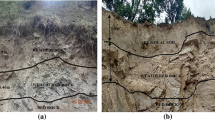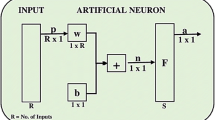Abstract
Investigations of failures of soil masses are subjects touching both geology and engineering. These investigations call the joint efforts of engineering geologists and geotechnical engineers. Geotechnical engineers have to pay particular attention to geology, ground water, and shear strength of soils in assessing slope stability. Artificial neural networks (ANNs) are very sophisticated modeling techniques, capable of modeling extremely complex functions. In particular, neural networks are nonlinear. In this research, with respect to the above advantages, ANN systems consisting of multilayer perceptron networks are developed to predict slope stability in a specified location, based on the available site investigation data from Noabad, Mazandaran, Iran. Several important parameters, including total stress, effective stress, angle of slope, coefficient of cohesion, internal friction angle, and horizontal coefficient of earthquake, were used as the input parameters, while the slope stability was the output parameter. The results are compared with the classical methods of limit equilibrium to check the ANN model’s validity.
ملخص
دراسة إخفاقات التربة مواضيع تخص علم الأرض والهندسة. هذه الدراسة تحتاج إلى مجهودات المهندسين في الجيولوجيا والمهندسين الجيوتقنيين. المهندس الجيوتقني يجب أن يهتم بالجيولوجيا، بالمياه الجوفية ومدى قوة التربة للإستقرار في الإنحدار. يعتبر نموذج الشبكة الشوكي الإصطناعي (ش.ش.ص) طريقة لدراسة الوظائف المعقدة. في هذه الدراسة، استعملنا هذا النموذج لتحديد مدى استقرار الإنحدار في منطقة معينة معتمدين على بيانات سابقة بمنطقة نًُوبَادْ/مزَنْدَرانْ وإيران. معالم عديدة تخص القوة الإجمالية، القوة الفعالة، زاوية الإنحدار، عامل التماسك، زاوية الإحتكاك الداخلي، والعامل الأفقي للزلزال، هذه البيانات كانت محددة، بينما الإستقرار للإنحدار كان مستنتجا. نتائج هذه الدراسة قورنت بالطرق المعروفة في استنتاج حدود التوازن، لمراجعة مدى شرعية النموذج.













Similar content being viewed by others
References
Attoh-Okine NO (2002) Combining use of rough set and artificial neural network in doweled-pavement performance modeling—a hybrid approach. ASCE J Transport Eng 128(3):270–275
Banimahd M, Yasrobi SS, Woodward PK (2005) Artificial neural network for stress–strain behavior of sandy soils: knowledge based verification. Comput Geotech 23:377–386
Beale R, Jackson T (1990) Neural computing: an introduction. Institute of Publishing, Bristol and Philadelphia
Blyth FG, deFrieitas MH (1976) A geology for engineering, 6th edn. Arnold, London
Charles JA, Soares MM (1984) Stability of compacted rockfill slopes. Geotechnique 34(1):61–70
Choobbasti AJ (1997) Numerical simulation of liquefaction. Ph.D. thesis submitted to the University of Manchester Institute of Science and Technology (UMIST)
Collins IF, Gunn CIM, Pender MJ, Yan W (1988) Slope stability analyses for materials with a non-linear failure envelope. Int J Numer Analyt Meth Geomech 12:533–550
Cormeau IC (1975) Numerical stability in quasi-static elasto/visco-plasticity. Int J Numer Meth Eng (1975) 9:109–127
Farrokhzad F (2007) Assessing liquefaction using artificial neural netwrok. MSc research submitted to the Babol University of Technology, Iran
Farrokhzad F (2008) Babol liquefaction zonation using artificial neural network. MSc thesis submitted to the Babol University of Technology, Iran
Flood I, Kartam N (1994a) Neural network in civil engineering. I: principles and understandings. J Comput Civ Eng ASCE 8(2):131–148
Flood I, Kartam N (1994b) Neural network in civil engineering. II: systems and applications. J Comput Civ Eng ASCE 8(2):149–162
Griffiths DV, Fenton GA (2004) Probabilistic slope stability analysis by finite elements. J Geotech Geoenviron Eng ASCE 130(5):507–518
Griffiths DV, Lane PA (1999) Slope stability analysis by finite elements. Geotechnique 49(3):387–403
Guo Z, Uhrig RE (1992) Use of artificial neural networks to analyze nuclear power plant performance. Nucl Technol 99:36–42
Gupta MM, Jin L, Homma N (2003) Static and dynamic neural network. Wiley, New York
Hosaini S (2005) Prediction of liquefaction potential using artificial neural network. MSc thesis submitted to the Babol University of Technology, Iran
Ishihara K (1986) Stability of natural deposits during earthquakes, collected papers, vol. 24. Department of Civil Engineering, Tokyo, pp 1–56
Legget RF, Hatheway AW (1988) Geology and engineering. McGraw-Hill, New York
Noori Y (2003) Prediction of subsurface soil layers using artificial neural network. MSc thesis submitted to the Babol University of Technology, Iran
Skempton AW, Hutchinson J (1969) Stability of natural slopes and embankment foundations. Proceeding 7th international conference on soil mechanics and foundation engineering, Mexico, State of Earth Report, pp 291–340
Terzaghi K (1950) Mechanism of landslides. In: Paige S (ed) Application of geology to engineering practice (Berkey volume). Geological Society of America, New York, pp 83–123
Winterkorn HF, Fang HY (1975) Foundation engineering handbook. Van Nostrand Reinhold, New York
Author information
Authors and Affiliations
Corresponding author
Rights and permissions
About this article
Cite this article
Choobbasti, A.J., Farrokhzad, F. & Barari, A. Prediction of slope stability using artificial neural network (case study: Noabad, Mazandaran, Iran). Arab J Geosci 2, 311–319 (2009). https://doi.org/10.1007/s12517-009-0035-3
Received:
Accepted:
Published:
Issue Date:
DOI: https://doi.org/10.1007/s12517-009-0035-3




